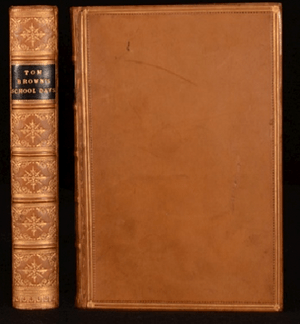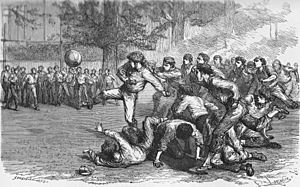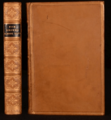Tom Brown's School Days facts for kids

Spine and cover of first edition.
|
|
| Author | Thomas Hughes |
|---|---|
| Country | United Kingdom |
| Language | English |
| Genre | School story |
| Publisher | Macmillan |
|
Publication date
|
1857 |
| Media type | Print (calfskin binding) |
| Pages | 420 |
| ISBN | 0-19-283535-1 |
| OCLC | 42414413 |
| 823.8 | |
| LC Class | PR4809.H8 T66 1999 |
| Followed by | Tom Brown at Oxford |
| Text | Tom Brown's School Days at Wikisource |
Tom Brown's School Days is a famous novel written by Thomas Hughes in 1857. It tells the story of a boy named Tom Brown and his time at Rugby School. This is a real English public school where Hughes himself studied from 1834 to 1842.
The book was first published by "an Old Boy of Rugby," meaning someone who used to go there. Many parts of the story are based on Hughes's own experiences. The character of Tom Brown is a lot like Hughes's brother, George Hughes. Another main character, George Arthur, is thought to be based on Arthur Penrhyn Stanley.
The story also features Dr Thomas Arnold, who was the real headmaster of Rugby School from 1828 to 1841. Tom Brown's School Days has been made into several movies and TV shows. It also helped create a popular type of British school novel, inspiring stories like those about Billy Bunter and Mr Chips. A sequel, Tom Brown at Oxford, came out in 1861.
Contents
Tom Brown's School Journey
The story follows Tom Brown, a lively and kind-hearted boy. He is good at sports but not so much with books. Tom often follows his feelings and the unspoken rules among his friends.
Tom's Early Life
The first part of the book describes Tom's childhood at home. He lives in a beautiful area called the Vale of White Horse. This peaceful time, where young Tom rides his pony freely, is a big contrast to his tough first years at school.
Starting Rugby School
Tom first attends a local school. Then, he goes to a private school, but an illness forces him to leave. At age eleven, Tom transfers to Rugby School.
When Tom arrives, an older student named Harry "Scud" East helps him settle in. Tom's main enemy at Rugby is a bully named Flashman. Flashman's bullying gets worse. After Tom refuses to give him a ticket for a horse race, Flashman purposely burns Tom in front of a fire. Tom and East finally defeat Flashman with help from Diggs, a friendly older boy.
New Friendships and Lessons
In the second part of the book, Dr Thomas Arnold gives Tom a special job. Tom must look after George Arthur, a new boy who is shy, smart, and not very strong. Tom gets into a fight to protect Arthur. Arthur also gets very sick with a fever.
Tom and Arthur help each other grow. They learn to be good gentlemen, saying their prayers and not cheating on homework. They even play in a big cricket match together. The book ends with Tom returning to Rugby's chapel when he hears that Dr Arnold has passed away.
Who's Who in the Story
- Tom Brown: The main character who learns important life lessons at Rugby School.
- Harry "Scud" East: An older student who helps Tom when he first arrives.
- Dr Thomas Arnold: The real headmaster of Rugby School, shown as a wise teacher.
- Flashman: The school bully who causes trouble for Tom.
- Diggs: A funny older student who helps Tom and East against Flashman.
- George Arthur: A new, gentle student whom Tom guides and protects.
Key Ideas in the Book
A big part of the novel is about Rugby School itself. It shows the school's traditions and the changes made by Dr Arnold. He is shown as a perfect teacher who guides everything behind the scenes. For example, he is the one who pairs Tom with Arthur.
The main idea of the book is how boys grow up and develop. Tom and Arthur help each other in different ways. Tom brings strength, courage, and friendliness. Arthur brings good morals and Christian values. This shows that the author, Thomas Hughes, believed both physical and moral growth were important.
Hughes wrote the book to teach lessons, not just to entertain. He said his main goal was to "preach" or share his ideas about how boys should be raised.
The Book's Influence
Tom Brown's School Days made the "school story" type of book much more popular. Even though other school stories existed before, this book brought them to many more readers. It influenced later fictional schools like Billy Bunter's Greyfriars School and Mr Chips' Brookfield. It even inspired J. K. Rowling's Harry Potter series, which has many similar ideas and structures.
The book also describes a game of rugby football, which was played at Rugby School. The book's popularity helped spread this sport beyond the school.
In Japan, Tom Brown's School Days was a very popular book for high school students learning English. It was translated into Japanese many times, helping to share British education ideas.
Movies and Shows
Tom Brown's School Days has been made into several movies and TV shows:
- Tom Brown's Schooldays (1916 film) (a silent movie)
- Tom Brown's School Days (1940 film)
- Tom Brown's Schooldays (1951 film)
- Tom Brown's Schooldays (1971 TV miniseries)
- Tom Brown's Schooldays (2005 TV film)
In the 1940 American movie, Cedric Hardwicke played Dr Thomas Arnold. Critics praised his performance. The 1951 British film starred Robert Newton as Dr Arnold and John Howard Davies as Tom Brown.
The 1971 TV series by the BBC starred Anthony Murphy as Tom and Iain Cuthbertson as Dr Arnold. This show won Emmy Awards. The 2005 TV film from ITV starred Alex Pettyfer as Tom and Stephen Fry as Dr Arnold.
There was also a musical version of the story in London in 1971.
Flashman's Own Story
The character of Flashman, the bully from Tom Brown's School Days, became famous in his own right. A British writer named George MacDonald Fraser wrote a popular series of historical novels called The Flashman Papers. These books follow Flashman as an adult, often getting into trouble.
In one of these books, Flashman in the Great Game, the adult Flashman reads Tom Brown's School Days. He finds its popularity about his youth quite annoying! Fraser's Flashman novels also include other characters from the original book, like George Speedicut and even Tom Brown himself. Flashman also meets "Scud" East again in later adventures.
Images for kids



